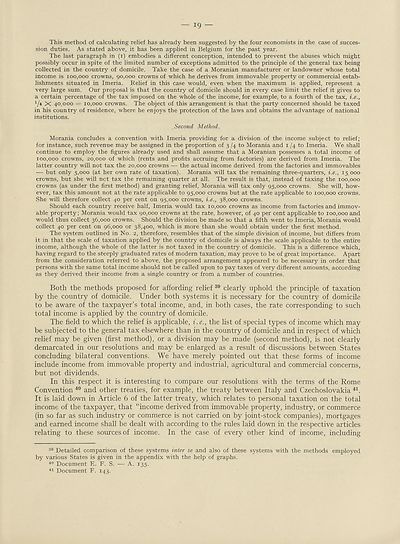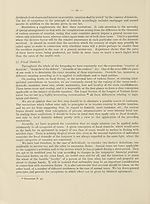Download files
Complete book:
Individual page:
Thumbnail gallery: Grid view | List view

i9 —
This method of calculating relief has already been suggested by the four economists in the case of succes¬
sion duties. As stated above, it has been applied in Belgium for the past year.
The last paragraph in (i) embodies a different conception, intended to prevent the abuses which might
possibly occur in spite of the limited number of exceptions admitted to the principle of the general tax being
collected in the country of domicile. Take the case of a Moranian manufacturer or landowner whose total
income is 100,000 crowns, 90,000 crowns of which he derives from immovable property or commercial estab¬
lishments situated in Imeria. Relief in this case would, even when the maximum is applied, represent a
very large sum. Our proposal is that the country of domicile should in every case limit the relief it gives to
a certain percentage of the tax imposed on the whole of the income, for example, to a fourth of the tax, i.e.,
74 X 40,000 = 10,000 crowns. The object of this arrangement is that the party concerned should be taxed
in his country of residence, where he enjoys the protection of the laws and obtains the advantage of national
institutions.
, Second Method.
Morania concludes a convention with Imeria providing for a division of the income subject to relief;
for instance, such revenue may be assigned in the proportion of 3 /4 to Morania and 1 /4 to Imeria. We shall
continue to employ the figures already used and shall assume that a Moranian possesses a total income of
100,000 crowns, 20,000 of which (rents and profits accruing from factories) are derived from Imeria. The
latter country will not tax the 20,000 crowns — the actual income derived from the factories and immovables
— but only 5,000 (at her own rate of taxation). Morania will tax the remaining three-quarters, i.e., 15.000
crowns, but she will net tax the remaining quarter at all. The result is that, instead of taxing the 100,000
crowns (as under the first method) and granting relief, Morania will tax only 95,000 crowns. She will, how¬
ever, tax this amount not at the rate applicable to 95,000 crowns but at the rate applicable to 100,000 crowns.
She will therefore collect 40 per cent on 95,000 crowns, i.e., 38,000 crowns.
Should each country receive half, Imeria would tax 10,000 crowns as income from factories and immov¬
able property; Morania would tax 90,000 crowns at the rate, however, of 40 per cent applicable to 100,000 and
would thus collect 36,000 crowns. Should the division be made so that a fifth went to Imeria, Morania would
collect 40 per cent on 96,000 or 38,400, which is more than she would obtain under the first method.
The system outlined in No. 2, therefore, resembles that of the simple division of income, but differs from
it in that the scale of taxation applied by the country of domicile is always the scale applicable to the entire
income, although the whole of the latter is not taxed in the country of domicile. This is a difference which,
having regard to the steeply graduated rates of modern taxation, may prove to be of great importance. Apart
from the consideration referred to above, the proposed arrangement appeared to be necessary in order that
persons with the same total income should not be called upon to pay taxes of very different amounts, according
as they derived their income from a single country or from a number of countries.
Both the methods proposed for affording relief 39 clearly uphold the principle of taxation
by the country of domicile. Under both systems it is necessary for the country of domicile
to be aware of the taxpayer’s total income, and, in both cases, the rate corresponding to such
total income is applied by the country of domicile.
The field to which the relief is applicable, i.e., the list of special types of income which may
be subjected to the general tax elsewhere than in the country of domicile and in respect of which
relief may be given (first method), or a division may be made (second method), is not clearly
demarcated in our resolutions and may be enlarged as a result of discussions between States
concluding bilateral conventions. We have merely pointed out that these forms of income
include income from immovable property and industrial, agricultural and commercial concerns,
but not dividends.
In this respect it is interesting to compare our resolutions with the terms of the Rome
Convention 40 and other treaties, for example, the treaty between Italy and Czechoslovakia 41.
It is laid down in Article 6 of the latter treaty, which relates to personal taxation on the total
income of the taxpayer, that “income derived from immovable property, industry, or commerce
(in so far as such industry or commerce is not carried on by joint-stock companies), mortgages
and earned income shall be dealt with according to the rules laid down in the respective articles
relating to these sources of income. In the case of every other kind of income, including
39 Detailed comparison of these systems inter se and also of these systems with the methods employed
by various States is given in the appendix with the help of graphs.
40 Document E. F. S. — A. 135.
41 Document F. 143.
This method of calculating relief has already been suggested by the four economists in the case of succes¬
sion duties. As stated above, it has been applied in Belgium for the past year.
The last paragraph in (i) embodies a different conception, intended to prevent the abuses which might
possibly occur in spite of the limited number of exceptions admitted to the principle of the general tax being
collected in the country of domicile. Take the case of a Moranian manufacturer or landowner whose total
income is 100,000 crowns, 90,000 crowns of which he derives from immovable property or commercial estab¬
lishments situated in Imeria. Relief in this case would, even when the maximum is applied, represent a
very large sum. Our proposal is that the country of domicile should in every case limit the relief it gives to
a certain percentage of the tax imposed on the whole of the income, for example, to a fourth of the tax, i.e.,
74 X 40,000 = 10,000 crowns. The object of this arrangement is that the party concerned should be taxed
in his country of residence, where he enjoys the protection of the laws and obtains the advantage of national
institutions.
, Second Method.
Morania concludes a convention with Imeria providing for a division of the income subject to relief;
for instance, such revenue may be assigned in the proportion of 3 /4 to Morania and 1 /4 to Imeria. We shall
continue to employ the figures already used and shall assume that a Moranian possesses a total income of
100,000 crowns, 20,000 of which (rents and profits accruing from factories) are derived from Imeria. The
latter country will not tax the 20,000 crowns — the actual income derived from the factories and immovables
— but only 5,000 (at her own rate of taxation). Morania will tax the remaining three-quarters, i.e., 15.000
crowns, but she will net tax the remaining quarter at all. The result is that, instead of taxing the 100,000
crowns (as under the first method) and granting relief, Morania will tax only 95,000 crowns. She will, how¬
ever, tax this amount not at the rate applicable to 95,000 crowns but at the rate applicable to 100,000 crowns.
She will therefore collect 40 per cent on 95,000 crowns, i.e., 38,000 crowns.
Should each country receive half, Imeria would tax 10,000 crowns as income from factories and immov¬
able property; Morania would tax 90,000 crowns at the rate, however, of 40 per cent applicable to 100,000 and
would thus collect 36,000 crowns. Should the division be made so that a fifth went to Imeria, Morania would
collect 40 per cent on 96,000 or 38,400, which is more than she would obtain under the first method.
The system outlined in No. 2, therefore, resembles that of the simple division of income, but differs from
it in that the scale of taxation applied by the country of domicile is always the scale applicable to the entire
income, although the whole of the latter is not taxed in the country of domicile. This is a difference which,
having regard to the steeply graduated rates of modern taxation, may prove to be of great importance. Apart
from the consideration referred to above, the proposed arrangement appeared to be necessary in order that
persons with the same total income should not be called upon to pay taxes of very different amounts, according
as they derived their income from a single country or from a number of countries.
Both the methods proposed for affording relief 39 clearly uphold the principle of taxation
by the country of domicile. Under both systems it is necessary for the country of domicile
to be aware of the taxpayer’s total income, and, in both cases, the rate corresponding to such
total income is applied by the country of domicile.
The field to which the relief is applicable, i.e., the list of special types of income which may
be subjected to the general tax elsewhere than in the country of domicile and in respect of which
relief may be given (first method), or a division may be made (second method), is not clearly
demarcated in our resolutions and may be enlarged as a result of discussions between States
concluding bilateral conventions. We have merely pointed out that these forms of income
include income from immovable property and industrial, agricultural and commercial concerns,
but not dividends.
In this respect it is interesting to compare our resolutions with the terms of the Rome
Convention 40 and other treaties, for example, the treaty between Italy and Czechoslovakia 41.
It is laid down in Article 6 of the latter treaty, which relates to personal taxation on the total
income of the taxpayer, that “income derived from immovable property, industry, or commerce
(in so far as such industry or commerce is not carried on by joint-stock companies), mortgages
and earned income shall be dealt with according to the rules laid down in the respective articles
relating to these sources of income. In the case of every other kind of income, including
39 Detailed comparison of these systems inter se and also of these systems with the methods employed
by various States is given in the appendix with the help of graphs.
40 Document E. F. S. — A. 135.
41 Document F. 143.
Set display mode to:
![]() Universal Viewer |
Universal Viewer | ![]() Mirador |
Large image | Transcription
Mirador |
Large image | Transcription
Images and transcriptions on this page, including medium image downloads, may be used under the Creative Commons Attribution 4.0 International Licence unless otherwise stated. ![]()
| League of Nations > Economic and financial section > Double taxation and tax evasion > (25) |
|---|
| Permanent URL | https://digital.nls.uk/190911633 |
|---|
| Shelfmark | LN.II |
|---|
| Description | Over 1,200 documents from the non-political organs of the League of Nations that dealt with health, disarmament, economic and financial matters for the duration of the League (1919-1945). Also online are statistical bulletins, essential facts, and an overview of the League by the first Secretary General, Sir Eric Drummond. These items are part of the Official Publications collection at the National Library of Scotland. |
|---|---|
| Additional NLS resources: |
|

